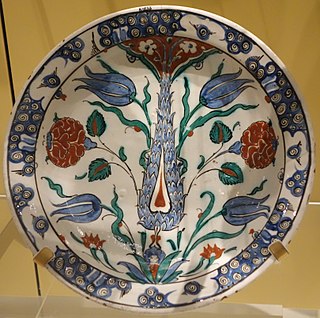
Pottery and porcelain, is one of the oldest Japanese crafts and art forms, dating back to the Neolithic period. Kilns have produced earthenware, pottery, stoneware, glazed pottery, glazed stoneware, porcelain, and blue-and-white ware. Japan has an exceptionally long and successful history of ceramic production. Earthenwares were created as early as the Jōmon period, giving Japan one of the oldest ceramic traditions in the world. Japan is further distinguished by the unusual esteem that ceramics holds within its artistic tradition, owing to the enduring popularity of the tea ceremony.
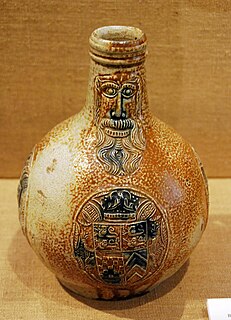
Salt-glaze or salt glaze pottery is pottery, usually stoneware, with a glaze of glossy, translucent and slightly orange-peel-like texture which was formed by throwing common salt into the kiln during the higher temperature part of the firing process. Sodium from the salt reacts with silica in the clay body to form a glassy coating of sodium silicate. The glaze may be colourless or may be coloured various shades of brown, blue, or purple.

Korean ceramic history begins with the oldest earthenware dating to around 8000 BC. Influenced by Chinese ceramics, Korean pottery developed a distinct style of its own, with its own shapes, such as the moon jar or maebyeong version of the Chinese meiping vase, and later styles of painted decoration. Korean ceramic trends had an influence on Japanese pottery and porcelain. Examples of classic Korean wares are the celadons of the Goryeo dynasty (918–1392) and the white porcelains of the Joseon dynasty (1392–1897).
Studio pottery is pottery made by professional and amateur artists or artisans working alone or in small groups, making unique items or short runs. Typically, all stages of manufacture are carried out by the artists themselves. Studio pottery includes functional wares such as tableware and cookware, and non-functional wares such as sculpture. Studio potters can be referred to as ceramic artists, ceramists, ceramicists or as an artist who uses clay as a medium. Much studio pottery is tableware or cookware, but an increasing number of studio potters produce non-functional or sculptural items. In Britain since the 1980s, there has been a distinct trend away from functional pottery, for example, the work of artist Grayson Perry. Some studio potters now prefer to call themselves ceramic artists, ceramists or simply artists. Studio pottery is represented by potters all over the world and has strong roots in Britain.
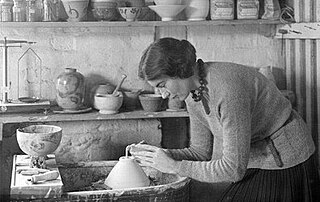
Ursula Frances Elinor Mommens was an English potter. Mommens studied at the Royal College of Art, under William Staite Murray, and later worked with Michael Cardew at Winchcombe Pottery and Wenford Bridge Pottery.

Ceramic glaze is an impervious layer or coating of a vitreous substance which has been fused to a ceramic body through firing. Glaze can serve to color, decorate or waterproof an item. Glazing renders earthenware vessels suitable for holding liquids, sealing the inherent porosity of unglazed biscuit earthenware. It also gives a tougher surface. Glaze is also used on stoneware and porcelain. In addition to their functionality, glazes can form a variety of surface finishes, including degrees of glossy or matte finish and color. Glazes may also enhance the underlying design or texture either unmodified or inscribed, carved or painted.
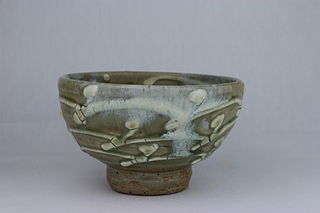
Takeshi Yasuda is a Japanese potter who was born in Tokyo, Japan in 1943. Yasuda trained at the Daisei-Gama Pottery in Mashiko from 1963 to 1966 and established his first studio there. His early work consisted of ash-glazed stoneware, after which he explored sancai and creamware. Most recently Yasuda has been working with celadon-glazed porcelain.
Steven Kemenyffy is an American ceramic artist living and working in Pennsylvania. He is most recognized for his contributions to the development of the American ceramic raku tradition. He has served as a Professor of Ceramic Art at Edinboro University of Pennsylvania since 1969. He Has retired from teaching, but continues to produce artwork at his home studio in McKean, Pennsylvania.
Tatsuzō Shimaoka was a Japanese mingei potter who studied under Shōji Hamada and later became the second Living National Treasure of Mashiko, Japan. He was best known for his unique Jōmon zogan style of pottery, and was a master of many slip decorating and firing techniques for pottery. Throughout his career, Shimaoka worked collaboratively with a group of workers, students, and apprentices from Japan and abroad. After supervising the loading of what would become his last noborigama firing in late 2007, Shimaoka collapsed, and died several weeks later in late 2007 from acute liver failure at Mashiko in Tochigi Prefecture.

Catawba Valley Pottery describes alkaline glazed stoneware made in the Catawba River Valley of Western North Carolina from the early 19th century, as well as certain contemporary pottery made in the region utilizing traditional methods and forms.

Derek Maynard Davis was an English artist, working in the media of painting and pottery. He was born in Wandsworth, South London, where he was educated at Emanuel School. He joined the King's Royal Rifle Corps in 1943, to fight in World War II. After the war he entered the Central School of Arts and Crafts in London. Together with his friend Eric James Mellon he then started a pottery workshop in Hillesden, Buckinghamshire. Later he left to work on his own, and moved to Arundel, West Sussex. Here he developed his ceramics further, coming up with several innovative techniques. An eye operation in 1994 left him unable to look through the hole in the pottery kiln, and after this he started focusing on painting instead.
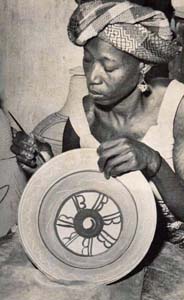
Ladi Kwali, OON, MBE was a Nigerian potter.
Eric Norstad was an American potter and architect who worked primarily on the west coast of the United States.

Charles Fergus Binns was an English-born studio potter. Binns was the first director of the New York State School of Clayworking and Ceramics, currently called the New York State College of Ceramics at Alfred University. He began his position in 1900 and retired in 1931. His work included authorship of several books on the history and practice of pottery. Some of his more notable students included Arthur Eugene Baggs, William Victor Bragdon, R. Guy Cowan, Maija Grotell and Elizabeth Overbeck. This has led Binns to be called "the father of American studio ceramics".

James C. Watkins was born in Louisville, Kentucky, in 1951 and raised in a farming family in Athens, Alabama. He is a ceramic artist living in Lubbock, Texas and is known for his large scale double-walled ceramic vessels and laser cut porcelain substrate tiles. He is recognized for his textured surfaces, created by using alternative firing techniques. His porcelain substrate tiles are fumed with stannous chloride and multi-fired using ferric chloride, gold and platinum luster to achieve colorful surfaces.

Ceramic art is art made from ceramic materials, including clay. It may take forms including art ware, tile, figurines, sculpture, and tableware. Ceramic art is one of the arts, particularly the visual arts. Of these, it is one of the plastic arts. While some ceramics are considered fine art, as pottery or sculpture, some are considered to be decorative, industrial or applied art objects. Ceramics may also be considered artefacts in archaeology. Ceramic art can be made by one person or by a group of people. In a pottery or ceramic factory, a group of people design, manufacture and decorate the art ware. Products from a pottery are sometimes referred to as "art pottery". In a one-person pottery studio, ceramists or potters produce studio pottery.

American art pottery refers to aesthetically distinctive hand-made ceramics in earthenware and stoneware from the period 1870-1950s. Ranging from tall vases to tiles, the work features original designs, simplified shapes, and experimental glazes and painting techniques. Stylistically, most of this work is affiliated with the modernizing Arts and Crafts (1880-1910), Art Nouveau (1890–1910), or Art Deco (1920s) movements. Art pottery was made by some 200 studios and small factories across the country, with especially strong centers of production in Ohio and Massachusetts. Most of the potteries were forced out of business by the economic pressures of competition from commercial mass-production companies as well as the advent of World War I followed a decade later by the Great Depression.
Karl Martz was an American studio potter, ceramic artist, and teacher whose work achieved national and international recognition.

The Coxwold Pottery was a pottery studio based in the village of Coxwold, North Yorkshire, launched by artist potters Peter and Jill Dick in 1965, and in operation until 2012.


